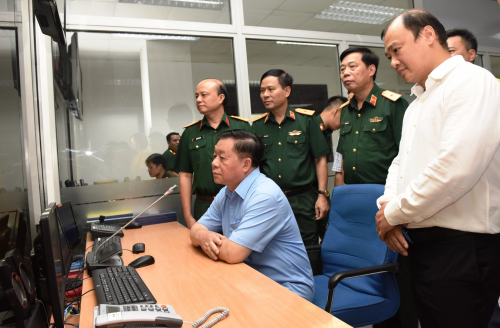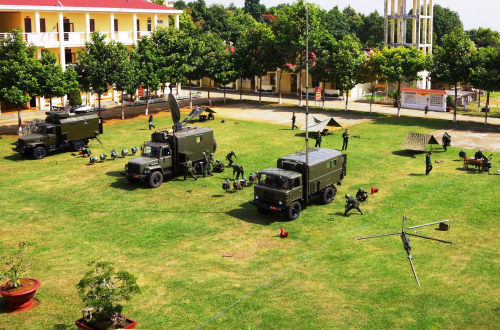Stepping up the implementation of the Strategy to develop the military communication system in the period of 2021 – 2030, with a vision towards 2045
Building a modern military signal force to contribute to building an “elite, compact, strong” Army towards modernity constitutes a strategy of our Party, Central Military Commission (CMC), and Ministry of National Defence (MND). Hence, the Signal Corps’ Party Committee and Command continue to focus their leadership and direction on realising “the Strategy to develop the military communication system in the period of 2021 – 2030, with a vision towards 2045” via drastic, synchronous measures.
 |
| Comrade Nguyen Trong Nghia, Head of the Central Commission for Communication and Education, visits the Military Communication Command Centre |
According to the Resolutions of the 13th National Party Congress and the 16th Military Party Congress, the Signal Force will move straight to modernity. Over the years, thanks to regard by our Party and State, under the routine, direct leadership and direction by the CMC and MND, performing their function as the leading agency in army-wide communication, the Corps’ Party Committee and Command have assisted the CMC and MND in issuing and realising the Strategy to develop the military communication system in the period of 2021 – 2030, with a vision towards 2045 (hereafter the Strategy for short). This Strategy serves as an important orientation for building the military signal force with great synergy, combat power, and capability in ensuring timely, smooth, solid communication for performing tasks and especially protecting the Fatherland in the new situation.
Right after the issuance of the Strategy, the Corps’ Party Committee and Command have concentrated their leadership and direction on seriously, drastically implementing the Strategy via scientific, proper measures, thus achieving good results. Notably, cadres and soldiers of the Corps have shown their political steadfastness, good morality, discipline-abiding awareness, and great responsibility. The military communication system has been sustainably developed in terms of scale, technology, and communication mode. Communication organisation and assurance have been flexibly adjusted to be relevant to tasks and types of combat. Communication projects and works have been built in accordance with tasks of offices and units across the Military. Significance has been attached to providing technical support, equipment, and innovation, building and training human resources, thus meeting the requirements of military-defence tasks in the new situation.
However, there have been some difficulties in implementing the Strategy due to the rapid development of telecom technology, a lack of high-calibre human resources, the disrupted supply of technical materials for the building of the military communication system, the short shelf life of some types of technical materials, and a dearth of synchronicity in facilities. To fulfil the goals of the Strategy, in the upcoming time, the Corps’ Party Committee and Command decide to concentrate their leadership and direction on synchronously taking a number of main solutions as follows.
First, continuing to raise public awareness and a sense of responsibility among cadres, employees, and soldiers towards the implementation of the Strategy. The Corps’ Party Committee and Command will continue to direct affiliated offices and units to render cadres, employees, and soldiers fully aware of the significance and importance of the Strategy, thereby raising their responsibility for their task performance. Emphasis will be placed on resolutions and directives of the Party, CMC, and MND on building an “elite, compact, strong” Army towards modernity and a modern signal force, military-defence tasks in the new situation, hostile forces’ plots and artifices, the content of the Strategy, the Resolution of the 13th Party Central Committee’s 8th Plenum on the Strategy for Fatherland Protection in the New Situation, the goals, viewpoints, tasks, and measures for the development of the military communication system, particularly the application of advanced technologies and the 4th industrial revolution to Army building and the development of the military communication system.
In addition to carrying out propagation and education via work briefings and training courses, offices and units should employ other forms and methods of propagation and education, such as conferences and workshops and include this work in meetings, cultural activities, and broadcast on the internal radio system. At the same time, they should maintain close cooperation with press agencies both inside and outside the Military and organise visits to technology offices and businesses to exchange experience and raise the effectiveness of propagation and education.
 |
| An exercise on ensuring mobile communication |
Second, focusing on building human resources, especially the high-quality ones to meet the task requirements. Human resources in general, the high-calibre ones in particular play a decisive role in the building and development of a modern military communication system. Thus, the Corps’ Party Committee and Command advocate the building of a contingent of cadres and technical employees with great competence, fitness, and proper age range and quantity to guarantee a solid transition between generations. Great value will be attached to improving staff members’ professional competence to master new technical equipment, military hardware, and technologies. The Corps will well conduct the work of personnel planning and use and adopt preferential policies to attract high-quality human resources. Due attention will be paid to standardising training programs within schools under the Corps’ management, closely combining domestic and overseas training, and aligning basic training at schools with in-service training and self-improvement via practice to achieve the targets in each phase set by the road map for the Strategy.
Besides, consideration will be given to directing offices and units within the Corps and the signal force within military regions, army corps, and other specialised corps to raise the quality of training for troops, particularly signal station commanders and staff members of mobile signal detachments, ensuring that this force will have good health and political, military, and specialised knowledge and skills, allowing mobile signal detachments to acquire flexible manoeuvrability in all terrain and weather conditions and provide timely, smooth, solid communication for all situations, tasks, and areas.
Third, frequently inspecting, reviewing, adjusting, and supplementing projects and plans for implementing the Strategy. It will take a long time with many continuous steps to implement the Strategy. Meanwhile, there are a lot of difficulties in supplying high-quality technical materials; some guiding documents have yet to keep pace with the development of the 4th industrial revolution; budget is still limited. Thus, the Corps will continue to give advice to the CMC and MND on taking measures to modernise the military communication system, formulate and promulgate legal normative documents relating to state management of the military communication system, and make a request for additional budget for realising the goals of the Strategy. At the same time, the Corps will proactively review and adjust projects and plans on ensuring communication for tasks and new forms of combat both in peacetime and wartime. In the new context, the Corps should grasp the development of communication in modern warfare to formulate backup projects and plans in peacetime and maintain readiness for application of those projects and plans in emergencies or in the event of a war. In the medium term, due attention will be paid to opportunely adjusting and supplementing projects on ensuring communication for offices and units after their organisational adjustments, frequently practising projects on ensuring communication for combat readiness in each combat area, and providing solid communication and mobile television service for the protection of seas, islands, and border, for major political events of our country and Army, and for contingency tasks.
Additionally, the Corps will step up researches, proactively propose additions to the art of organising communication and preventive measures to ensure information security and safety, master and transfer technologies for designing and manufacturing a number of pieces of military communication equipment, and apply models of managing and organising system connection under the trend of command automation. It will gradually complete the standardisation of documents in each field in accordance with the development of telecom technology and Vietnamese military art.
Fourth, bringing into play synergy for implementing the Strategy. In response to the development of its tasks, the Corps will enhance investment in technology and proactively cooperate with telecom businesses both inside and outside the Military in researching, testing, and manufacturing military hardware, hi-tech communication equipment, and communication terminals. It will make network planning, exchange facilities, and step by step become self-sufficient in communication equipment provision and manufacture. Moreover, it will proactively encourage international cooperation, particularly in education and training, absorb and effectively apply achievements in science and technology, electronic telecom, and information technology to implementing the Strategy. It will actively renew technical work according to the motto of “proactiveness, creativity, development”, improve the capacity of its technical support centres, guarantee self-sufficiency in technical work, and build elite technical support teams. Last but not least, it will renew the organisation, management, and operation of the communication system, decentralise the exploitation of the communication system, step up the acquisition of new communication equipment, and focus on mastering, upgrading, and manufacturing equipment, materials, and spare parts to ensure timely, smooth, solid communication in any situation.
Sr. Col. VU VIET HOANG
Commander of the Signal Corps